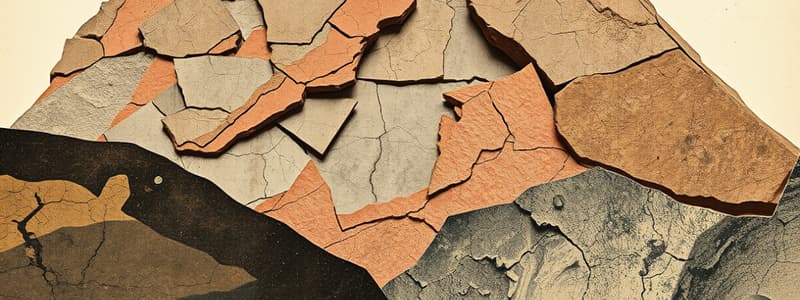Podcast
Questions and Answers
What is the change in mineral composition and texture of a rock subjected to high temperature within Earth?
What is the change in mineral composition and texture of a rock subjected to high temperature within Earth?
metamorphism
What changes in rock are caused by the heat from a nearby magma body?
What changes in rock are caused by the heat from a nearby magma body?
contact metamorphism
What type of metamorphism is associated with large-scale mountain-building processes?
What type of metamorphism is associated with large-scale mountain-building processes?
regional metamorphism
What is the hot, watery solution that escapes from a mass of magma during crystallization?
What is the hot, watery solution that escapes from a mass of magma during crystallization?
What type of metamorphic rock has a texture that gives it a layered appearance?
What type of metamorphic rock has a texture that gives it a layered appearance?
What is a metamorphic rock that does not exhibit a banded or layered appearance?
What is a metamorphic rock that does not exhibit a banded or layered appearance?
Where does most metamorphism take place?
Where does most metamorphism take place?
What are the three agents of metamorphism, and what kinds of changes does each cause?
What are the three agents of metamorphism, and what kinds of changes does each cause?
What are foliated metamorphic rocks, and how do they form?
What are foliated metamorphic rocks, and how do they form?
How are metamorphic rocks classified?
How are metamorphic rocks classified?
Compare and contrast contact metamorphism and regional metamorphism.
Compare and contrast contact metamorphism and regional metamorphism.
Contrast foliated and non-foliated metamorphic rocks.
Contrast foliated and non-foliated metamorphic rocks.
Name the agents of metamorphism and explain how each changes a rock.
Name the agents of metamorphism and explain how each changes a rock.
What are foliated rocks, and how do they form?
What are foliated rocks, and how do they form?
Flashcards are hidden until you start studying
Study Notes
Metamorphism Overview
- Metamorphism refers to changes in mineral composition and texture of rocks due to high temperatures within the Earth.
- Most metamorphism occurs several kilometers below the surface and extends into the upper mantle.
Types of Metamorphism
- Contact Metamorphism: Occurs when rocks are altered by heat from a nearby magma body, resulting in slight changes to their structure.
- Regional Metamorphism: Associated with large-scale mountain-building processes, leading to high-grade changes in both rock composition and structure.
Agents of Metamorphism
- Heat: Causes recrystallization of existing minerals and the formation of new minerals.
- Pressure: Increases rock density and compacts the structure; also promotes mineral recrystallization.
- Hydrothermal Solutions: Hot, mineral-rich fluids that can alter surrounding rocks during the later stages of magma crystallization.
Textures of Metamorphic Rocks
- Foliated Metamorphic Rocks: Characterized by a layered or banded appearance, formed when minerals realign due to pressure from opposing forces.
- Non-Foliated Metamorphic Rocks: Do not exhibit a banded or layered texture, indicating a uniform mineral composition.
Classification of Metamorphic Rocks
- Metamorphic rocks are classified based on their composition and texture, aiding in the identification of various rock types.
Comparison of Metamorphic Processes
- Contact vs. Regional Metamorphism:
- Contact metamorphism involves minimal structural changes from magma heat, while regional metamorphism results in significant compositional and structural changes associated with tectonic activities.
Summary of Each Agent's Effects
- Heat facilitates recrystallization and new mineral formation.
- Pressure enhances density and compacts rock structure.
- Fluids assist ion mobility and can dissolve and redeposit minerals during the metamorphic process.
Studying That Suits You
Use AI to generate personalized quizzes and flashcards to suit your learning preferences.




